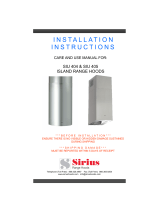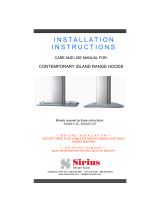
6
Gently tape the template to the wall making
sure it has no creases or folds (use a tape
that will not damage the wall nish). The-
re are three hole positions shown for the
wall bracket. Using a sharp object, mark
the wall through the template at the cen-
ter point of the three holes. Lower down on
the template, you will see three sets of two
holes. Only two of these holes refer to your
model. Check which model you have and,
using a sharp object, mark the two correct
holes. These holes are used to anchor the
range hood horizontally from inside the
hood once it has been hung from the main
bracket. Remove the template.
Fixing the Main Support Bracket
(CAUTION: Do not drill through any uti-
lities inside the wall).
If the range hood will be xed to drywall
we strongly recommend that you discard
the wall plugs and screws supplied. These
anchors are only suitable for brick/masonry
applications. We suggest the use of a more
appropriate anchor system specically de-
signed for drywall applications. Wherever
possible, it is advisable to place blocking
between the studs, behind the drywall, to
attach the support bracket to, (refer to Fi-
gure 4).
INSTALLATION
Positioning the Range Hood.
Determine the center point of the range
hood. This is generally the center of the
range. Make a mark on the wall a mini-
mum of 25” above the top of an electric
range. If the range is gas, the ideal mi-
nimum should be 30”.Using a spirit level,
draw a perfectly vertical line, starting at
the center mark, right up to the ceiling
or the highest point to where the hood
will extend. This is the central axis for
the range hood. Draw a horizontal line
fractionally above where the bottom of
the range hood will be positioned. This
is the underside of the range hood.
Marking the Fixing Holes for the Ran-
ge Hood.
Find the marking template provided cal-
led the “Assembly Scheme”. Place the
template against the wall. Align the ho-
rizontal line on the wall with the hori-
zontal line on the template (indicated by
two heavy arrows). Now align the ver-
tical line on the wall with the “Central
Axis” line on the template.
g. 3
g. 4
Drill the appropriate size holes at the
marks made earlier and x the Support
Bracket (“S”) securely to the wall. Ensure
that any wall anchors have been tted
into the lower two holes, as the range
hood will cover these holes once hung
on the Support Bracket (“S”).




















